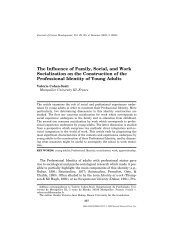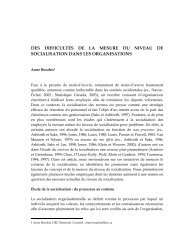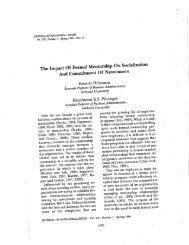Training in the 21st Century: Some Lessons from the Last One - Free
Training in the 21st Century: Some Lessons from the Last One - Free
Training in the 21st Century: Some Lessons from the Last One - Free
You also want an ePaper? Increase the reach of your titles
YUMPU automatically turns print PDFs into web optimized ePapers that Google loves.
44 Haccoun and Saks<br />
Self-Management and Relapse Prevention. Self-management<br />
and relapse prevention (RP) are two TEPs which appear to<br />
provide consistent positive results (Haccoun, Labreche<br />
and Saks., 1997; Haccoun, Murtada, & Desjard<strong>in</strong>s, 1997;<br />
Saks et al., 1997). These <strong>in</strong>terventions are essentially<br />
structured to help <strong>in</strong>dividuals identify environmental<br />
constra<strong>in</strong>ts for skill usage, and to develop strategies for<br />
overcom<strong>in</strong>g <strong>the</strong>m. Thus, <strong>the</strong>y help to <strong>in</strong>oculate <strong>the</strong> tra<strong>in</strong>ee<br />
aga<strong>in</strong>st <strong>the</strong> environment Moreover, <strong>the</strong> procedures are<br />
<strong>in</strong>tended to help tra<strong>in</strong>ees attribute skill use failures (so<br />
probable dur<strong>in</strong>g <strong>the</strong> early period after tra<strong>in</strong><strong>in</strong>g) not to<br />
failures of will but to failures of strategy. The ma<strong>in</strong> difference<br />
between <strong>the</strong> two is that self-management <strong>in</strong>cludes a<br />
behavioural as well as a motivational component (i.e., goal<br />
sett<strong>in</strong>g and self-reward), whereas relapse prevention is<br />
strictly behavioural (Gistetal., 1991).<br />
These approaches have resulted <strong>in</strong> <strong>in</strong>creased transfer<br />
<strong>in</strong> a number of actual tra<strong>in</strong><strong>in</strong>g contexts <strong>in</strong>clud<strong>in</strong>g <strong>the</strong><br />
military (Tz<strong>in</strong>er et al., 1991), and a hospital sett<strong>in</strong>g (Saks<br />
et al., 1996). They are associated with a number of<br />
parameters known to <strong>in</strong>fluence tra<strong>in</strong><strong>in</strong>g success <strong>in</strong>clud<strong>in</strong>g<br />
self-efficacy and perceived control. In effect, <strong>the</strong><br />
development of proactive, strategic actions which take<br />
<strong>in</strong>to account work level constra<strong>in</strong>ts may help build <strong>the</strong><br />
expectancies that tra<strong>in</strong>ed behaviour can be successfully<br />
implemented.<br />
S<strong>in</strong>ce environmental resistance to new skill usage is<br />
likely to wane over time, <strong>the</strong>se skills are especially<br />
important immediately after tra<strong>in</strong><strong>in</strong>g. It is for this reason<br />
that <strong>the</strong>y be specifically implemented at <strong>the</strong> end of a<br />
tra<strong>in</strong><strong>in</strong>g program, even if that requires a reduction <strong>in</strong> <strong>the</strong><br />
tra<strong>in</strong><strong>in</strong>g-time budgets allocated to content mastery.<br />
If <strong>the</strong> TEP approach can be demonstrated to be as<br />
fruitful as it appears to be, this can be a major help to<br />
tra<strong>in</strong><strong>in</strong>g systems <strong>in</strong> Canada and elsewhere for at least<br />
three reasons. First, <strong>the</strong> TEP approach relies on wellknown<br />
techniques, which are easily learned and easily<br />
<strong>in</strong>corporated <strong>in</strong>to tra<strong>in</strong><strong>in</strong>g programs, and <strong>the</strong>refore <strong>the</strong>y<br />
can be easily implemented <strong>in</strong> <strong>the</strong> field. Second, <strong>the</strong><br />
activities <strong>the</strong>y imply take place <strong>in</strong> <strong>the</strong> tra<strong>in</strong><strong>in</strong>g context,<br />
and <strong>the</strong>refore can be fully controlled by <strong>the</strong> tra<strong>in</strong><strong>in</strong>g<br />
function. The operational units' cooperation is not<br />
mandatory. Third, <strong>the</strong> sound underly<strong>in</strong>g psychological<br />
pr<strong>in</strong>ciples upon which <strong>the</strong>y are based frame <strong>the</strong> process<br />
of TEP creation thus facilitat<strong>in</strong>g <strong>the</strong> development of new<br />
techniques. However, I-O psychologists need to conduct<br />
much more research on <strong>the</strong>se techniques <strong>in</strong> order to<br />
provide tra<strong>in</strong>ers with <strong>in</strong>formation on how to best choose<br />
a TEP approach for any given tra<strong>in</strong><strong>in</strong>g program. This<br />
would be greatly aided by <strong>the</strong> use of a cont<strong>in</strong>gency<br />
approach for TEP usage.<br />
A cont<strong>in</strong>gency approach to TEP usage<br />
Although a number of pre- and post-tra<strong>in</strong><strong>in</strong>g TEPS have<br />
been found to be effective, <strong>the</strong>y have been used and<br />
tested without much consideration as to <strong>the</strong>ir appropriateness<br />
across tra<strong>in</strong><strong>in</strong>g situations. For example, consider<br />
<strong>the</strong> follow<strong>in</strong>g two hypo<strong>the</strong>tical studies, both test<strong>in</strong>g <strong>the</strong><br />
effects of goal sett<strong>in</strong>g and relapse prevention TEPs except<br />
<strong>in</strong> Study 1 tra<strong>in</strong>ees are given pre-tra<strong>in</strong><strong>in</strong>g TEPs and <strong>in</strong><br />
Study 2 <strong>the</strong>y are given post-tra<strong>in</strong><strong>in</strong>g TEPs. In study 1, <strong>the</strong><br />
results show that <strong>the</strong> RP subjects demonstrated greater<br />
transfer six months after tra<strong>in</strong><strong>in</strong>g. The researcher<br />
concludes that RP is a more effective TEP. In study 2, <strong>the</strong><br />
results show that <strong>the</strong> goal sett<strong>in</strong>g subjects demonstrated<br />
greater transfer six months after tra<strong>in</strong><strong>in</strong>g. The researcher<br />
concludes that goal sett<strong>in</strong>g is a more effective TEP. In an<br />
effort to be especially astute, <strong>the</strong> author writes up both<br />
studies toge<strong>the</strong>r and concludes that an RP TEP is best for<br />
pre-tra<strong>in</strong><strong>in</strong>g, and a goal sett<strong>in</strong>g TEP is best for posttra<strong>in</strong><strong>in</strong>g.<br />
These are all likely conclusions to be drawn<br />
<strong>from</strong> <strong>the</strong>se two studies.<br />
However, after some fur<strong>the</strong>r <strong>in</strong>quiry, <strong>the</strong> researcher<br />
discovers that <strong>in</strong> Study 1 <strong>the</strong> tra<strong>in</strong><strong>in</strong>g task was very<br />
complex and early goal sett<strong>in</strong>g <strong>in</strong>terfered with tra<strong>in</strong>ee<br />
learn<strong>in</strong>g. In Study 2, <strong>the</strong> work environment was found to<br />
be highly supportive of tra<strong>in</strong>ees with a strong learn<strong>in</strong>g<br />
culture and a positive tra<strong>in</strong><strong>in</strong>g climate. In effect, <strong>the</strong>re is<br />
no need for an RP <strong>in</strong>tervention <strong>in</strong> such an obstacle-free<br />
environment, but a goal-sett<strong>in</strong>g <strong>in</strong>tervention was just<br />
what was needed to motivate <strong>the</strong> tra<strong>in</strong>ees to achieve high<br />
levels of transfer. Thus, <strong>the</strong> results of both studies are <strong>in</strong><br />
large part due to <strong>the</strong> factors specific to <strong>the</strong> tra<strong>in</strong><strong>in</strong>g<br />
situation. In Study 1, goal sett<strong>in</strong>g was <strong>in</strong>appropriate<br />
dur<strong>in</strong>g <strong>the</strong> early stages of learn<strong>in</strong>g a complex task<br />
(Kanfer & Ackerman, 1989), while <strong>in</strong> Study 2, RP was<br />
redundant <strong>in</strong> a highly supportive environment.<br />
Because previous research has tested TEPs without<br />
consider<strong>in</strong>g <strong>the</strong>ir appropriateness for <strong>the</strong> tra<strong>in</strong><strong>in</strong>g<br />
situation, we do not know how useful various TEPs are for<br />
different tra<strong>in</strong><strong>in</strong>g situations. In o<strong>the</strong>r words, it is not yet<br />
clear when it is best to use a TEP (pre- versus post-tra<strong>in</strong><strong>in</strong>g)<br />
, or what type of TEP will be most effective <strong>in</strong> a<br />
particular tra<strong>in</strong><strong>in</strong>g situation. As a result, tra<strong>in</strong>ers will have<br />
a difficult time try<strong>in</strong>g to determ<strong>in</strong>e when to use a TEP,<br />
and more importantly, what type to use. l-o psychology<br />
can help by provid<strong>in</strong>g some guidel<strong>in</strong>es to ensure that<br />
TEPs are used to <strong>the</strong>ir maximum benefit.<br />
In terms of <strong>the</strong> tim<strong>in</strong>g of a TEP (pre or post), it would<br />
be useful for tra<strong>in</strong>ers to have some <strong>in</strong>formation on<br />
ma<strong>in</strong>tenance curves as discussed by Baldw<strong>in</strong> and Ford<br />
(1988). Ma<strong>in</strong>tenance curves <strong>in</strong>dicate <strong>the</strong> changes <strong>in</strong><br />
tra<strong>in</strong><strong>in</strong>g usage that occur <strong>in</strong> <strong>the</strong> transfer sett<strong>in</strong>g as a<br />
function of <strong>the</strong> time elapsed s<strong>in</strong>ce completion of a tra<strong>in</strong><strong>in</strong>g<br />
program. Thus, <strong>the</strong>y <strong>in</strong>dicate when a relapse occurs<br />
and <strong>the</strong>refore, when a TEP is mostly likely to be needed.<br />
In addition, one can simply consider tra<strong>in</strong>ees <strong>in</strong> terms<br />
of <strong>the</strong>ir motivation to learn and motivation to transfer,





